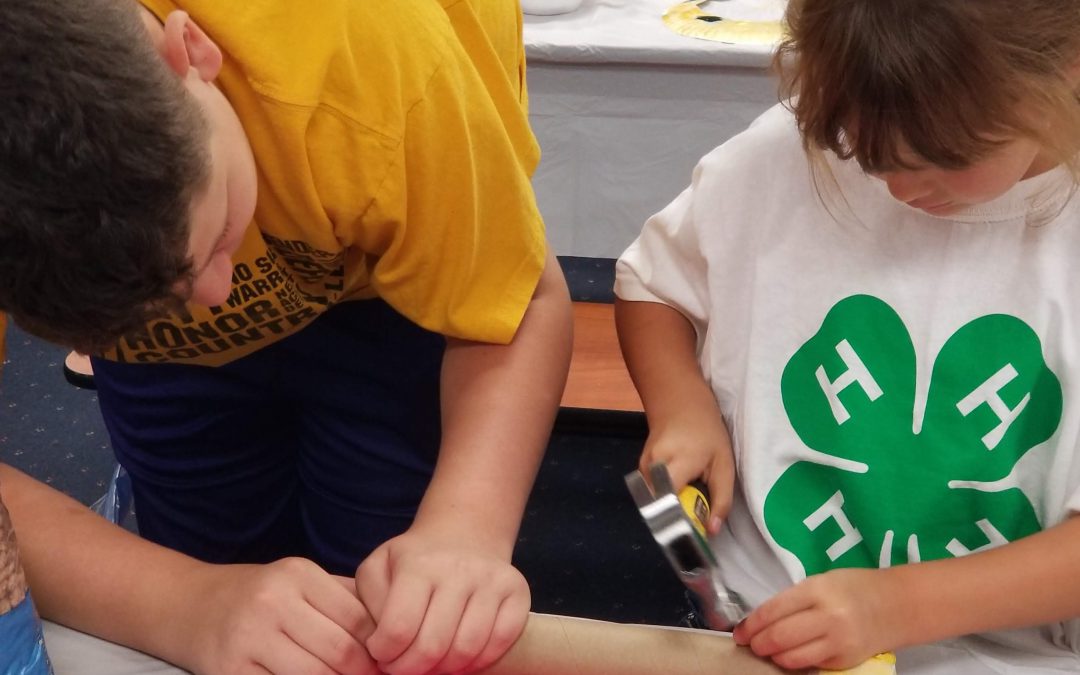
by Niki Crawson | May 19, 2023
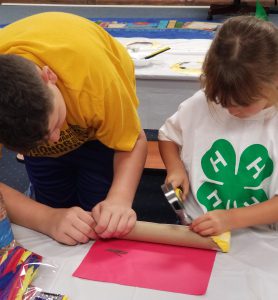
We know that younger youth look up to older youth and like to model their behaviors. We see it in siblings all the time, absorbing behaviors of their older brothers or sisters like sponges. Often times, younger youth find the attention and encouragement of older youth more relatable due to the closeness in age. Peer teaching fosters a more engaging and even symbiotic learning experience as this gives teens the opportunity to share and reinforce their own knowledge. In addition, by pairing the two age groups together in a learning environment, a sense of comradery can develop, creating a greater sense of belonging within the 4-H community. In this post, we will define peer teaching, share a few examples of how to utilize your teens as teachers and provide tips for getting peer teaching started in your clubs and other 4-H events and activities successfully.

WHAT IS PEER TEACHING?
What do we mean by peer teaching exactly? It is the process of youth learning together and from each other through engaging, hands-on activities. In 4-H, we have the wonderful ability to utilize teens as volunteers and positive role models for our younger youth in our positive youth development programs. Empowering our teens as teachers for our younger members allows life skills to develop among our youth being instructed and also the instructors. The teen instructors are teaching specific topics to their peers at the same time they are strengthening their own leadership, communication, and social skills.
WHAT ARE THE BENEFITS OF PEER TEACHING?
As stated previously, one of the greatest outcomes is that the teacher and the student both gain knowledge and skills. It creates a mutually beneficial environment in which all youth can achieve personal growth and development if implemented and managed correctly. In addition, there are many other benefits of peer teaching such as:
- Peers being taught may form a quicker and better connection with teens due to communication, technology and other trends.
- An increase in peer confidence as they may feel more comfortable in asking questions, discussing topics with others closer to their age.
- Greater creativity as teens may have more innovative or modern ideas to bring to the activities.
- An increase in volunteers as teens have the ability to recruit more teens easier than typical adult volunteers.
- An increase in retention of youth as peers stay in the program and become the next generation of teen volunteers/teachers.
WHAT DOES PEER TEACHING LOOK LIKE IN 4-H?
Below are just a few programs for teens to practice the method of peer teaching in their 4-H county:
- New Members – When new youth join 4-H, it can be overwhelming at times to learn some of the 4-H activities, customs, and such. This would be a great opportunity for
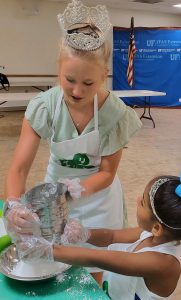 peer teaching. Have teens assigned to new members that join in order to teach them the 4-H pledge, motto, club expectations, member names, etc. This creates a greater sense of belonging and fosters a supportive environment within the club for new members to engage more quickly and successfully.
peer teaching. Have teens assigned to new members that join in order to teach them the 4-H pledge, motto, club expectations, member names, etc. This creates a greater sense of belonging and fosters a supportive environment within the club for new members to engage more quickly and successfully.
- Cloverbud Club Meetings – Utilizing your teen members in club meetings involving Cloverbuds (members ages 5-7) is a great way to incorporate peer teaching in your 4-H program. Younger members thrive off of creativity and enthusiasm which teens often portray easily. Teens can funnel this energy into teaching lessons to Cloverbuds that are engaging and interactive in a simplistic way.
- Summer Day Camps – 4-H programs often times need additional volunteers during the summer to assist with the volume of programming and youth participants. Therefore, summer is a great time to recruit teens to become peer teachers. Having teens as peer teachers helps with supervision and instruction while at the same time, allows them to stay involved in 4-H, continue to apply their life skills learned, and help the program teach life skills to other youth in the community.
TIPS TO GET PEER TEACHING STARTED IN YOUR 4-H COUNTY
What does it take to get peer teaching started in your 4-H county? Time and patience to start with. Teaching with teens is an ongoing task and will take a little effort on your part. Below are a few tips to get you started on having teens peer teach in your county:
- Identify programming that would benefit by peer teaching.
- Recruit quality teen teachers.
- Train and support teens as peer teachers.
- Assign teens appropriate roles in the peer teacher process.
- Model appropriate teaching methods in 4-H programs.
- Shadow teens in the role as peer teachers to provide support and guidance.
- Evaluate, provide feedback, and continue professional development for continued success.
Remember, peer teaching is a great way to utilize teen members in your 4-H programs. Younger youth need as many positive role models as possible in their lives. By having teen teachers take the lead in instruction in your 4-H programs, you are fostering an environment of learning, inclusivity, empowerment, and leadership.
To learn more about 4-H opportunities where teens can take the lead as teachers for their peers, please contact your local UF IFAS County Extension Office, or visit http://florida4h.org.
ADDITIONAL SOURCES:
Burse, G., Crocker, E. T., Jordan, J., McKinney, M., & Murphy, L. (2021). Teens as Teachers 4-H Project: Curriculum and Resources. UF/IFAS Extension, University of Florida. Retrieved May 1, 2023, from https://edis.ifas.ufl.edu/publication/4H432
Eckhoff, A., & Swistock, B. (2011). Staffing with Teenagers and Teens as Cross-Age Teachers. Rutgers Cooperative Extension.
by Niki Crawson | Apr 6, 2023
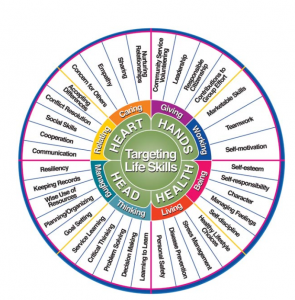
Figure 1. Hendricks, P. (1998) “Developing Youth Curriculum Using the Targeting Life Skills Model”
During the summertime, 4-H typically offers more opportunities for our teen audience since school is not in session as their schedules are more flexible. Because of this, we want to ensure that we are targeting skills that are specific to our teens’ immediate and future wellbeing and success.
In this article, I will discuss why life skills are so important, what 4-H programs already established target, which life skills are most beneficial for our teens and what, when, and how teens can get involved.
WHY DO WE CARE SO MUCH ABOUT LIFE SKILLS?
We know that life skills are abilities learned that help individuals reach their full potential in life. They assist in helping folks successfully handle day-to-day life experiences. We believe they are developed through hands-on learning, activities, and practice.
Life skills are the foundation of 4-H. Utilizing the Targeting Life Skills Wheel (Hendricks, 1998), we connect life skills through 4-H projects, programs, and events to real life experiences based on our Head, Heart, Hands and Health model. By helping youth achieve these life skills, 4-H professionals and volunteers are providing the framework for future academic and employment success, as well as youth thriving and community outreach.

Five essential life skills from the Targeting Life Skills Model commonly developed by participating in 4-H are:
- Communication
- Problem-solving
- Teamwork
- Responsibility
- Interpersonal Relationships
PROJECTS & EVENTS RELATED TO LIFE SKILLS FOR TEENS
Below are just a few 4-H projects and events in Florida 4-H for teens to get involved in to develop and strengthen essential life skills:
- 4-H Tailgating Contest – This program teaches healthy living and the science of grilling seafood, pork, poultry and beef safely outdoors. This program teaches decision making, healthy lifestyle choices, and communication life skills, among others.
- Gator Pit – The Gator Pit is a program open to all teens ages 14-18 in Florida. Youth are taught how to develop entrepreneurial skills through mentorship, competition, and networking to the business community.
- 4-H Legislative – Florida 4-H Legislature provides an opportunity for teens ages 14-18 to experience state government procedures and prepare them for potential leadership in the American democratic process. Youth learn, practice, and defend public policy.
- 4-H University – Florida 4-H University is an opportunity for teens to participate in educational workshops lead by UF faculty, explore potential careers, strengthen interpersonal relationships with peers, and develop critical life skills that will help them become leaders and engaged citizens in their communities.
The Florida 4-H Curriculum Clearinghouse is a list of 4-H resources available, including project curriculum, record books, club resources and other educational publications that meet the standards of Florida 4-H. In this site you can view resources for specific projects. To learn more about 4-H opportunities for teens, please contact your local UF IFAS County Extension Office, or visit http://florida4h.org.
ADDITIONAL SOURCES:
Hendricks, P.A. (1998). Developing Youth Curriculum Using the Targeting Life Skills Model: Incorporating Developmentally Appropriate Learning Opportunities to Assess Impact of Life Skill Development. Iowa State Extension Publication. https://extension.purdue.edu/4-H/about/impact-targeting-life-skills.
Irvine, K. (2019). What are Life Skills? https://blogs.ifas.ufl.edu/nassauco/2019/02/04/what-are-life-skills/
by Niki Crawson | Aug 26, 2022
 Joining a new group of individuals can be nerve-wracking for some that may be shy or intimidated by large groups. Incorporating team-building activities into your 4-H clubs and activities is a great way for 4-H members, new and returning, to form a connection with each other and will help set the tone for that particular group setting and/or event. In this post, we’ll provide tips to bring engaging team-building activities into your 4-H clubs and events. In addition, we will share some of the most popular team-building activities for various age groups that you can use to support your work with 4-H youth.
Joining a new group of individuals can be nerve-wracking for some that may be shy or intimidated by large groups. Incorporating team-building activities into your 4-H clubs and activities is a great way for 4-H members, new and returning, to form a connection with each other and will help set the tone for that particular group setting and/or event. In this post, we’ll provide tips to bring engaging team-building activities into your 4-H clubs and events. In addition, we will share some of the most popular team-building activities for various age groups that you can use to support your work with 4-H youth.
Together Everyone Achieves More
Teambuilding has been proven to have many benefits. Two of the most powerful benefits of team building are increased group morale and individual confidence. Having a new group of individuals learn to work collectively as a team builds rapport and trust. Teambuilding allows individuals to contribute their strengths to the team and also gain additional skills learned from others within the group. This allows for personal growth and development… However, teambuilding does not happen on its own- teams are formed over time with good leadership.
Bruce Tuckman’s Forming-Storming-Norming-Performing model (1965) is arguably the most recognized model for team development, and includes four stages of team development: Forming, Storming, Norming, Performing, and Adjourning:
- Forming: The leader shares goals, but there is no commitment yet; individual roles and responsibilities are unclear. Very leader driven at this point. This stage is essential to help reduce anxiety new members might feel joining a 4-H club or group and will help foster a sense of belonging.
- Storming: Trust hasn’t been established and decisions are difficult to make. Team members try to establish credibility with the group toward the end of this stage.
- Norming: The group is establishing trust—agreement is easier to reach, commitment to goals is evident, and decisions are being made.
- Performing: The group could function on its own without the leader because of the trust, commitment to goals, clarity, and ease of making decisions.
- Adjourning: Recognition and sensitivity to the break-up of the group is important as the team dissolves and members move on to other tasks.
Five Team Building Tips for 4-H Clubs or Groups
Below are five helpful tips for incorporating hands-on activities into your 4-H clubs and events in order to have successful teambuilding interaction:
- The teambuilding process can be longer for some groups than others- it really depends on the needs of the group and how often they meet or interact. If your group meets once a month, it might take longer than if your group is in the same cabin all week at camp.
- Select activities that will address the current needs of your group- if the group is already formed, move on to activities that promote storming.
- If you see a club or activity struggling with a group activity or plan of action, have them take a break and let them participate in a fun
 teambuilding exercise like “Helium Stick“
teambuilding exercise like “Helium Stick“
- Check out our Northwest 4-H Volunteer Google Site for more team-building activities and resources.
- Team building isn’t just for the youth! Consider planning a teambuilding workshop or a night of minute-to-win-it games with your youth vs volunteers or even a 4-H Family night with youth, parents/guardians, and volunteers. This will become a request for an annual event guaranteed!
Five Team Building Activities for “Forming”
The new 4-H year kicks off in just a few days, which means that most 4-H clubs or groups are in the “forming” stage. To help, below are five fun and easy activities you can do with your team to promote “forming.” For more activities and ideas to support all five stages of team building, download our free 4-H Team Building Handbook for a quick reference tool!
- Start your meeting with an easy get-to-know-you icebreaker like “The Superlative Game” in which youth line up based on their birthday, height or age without talking.
- Who’s in the Bag? Ask each person to select an object that represents something about themselves. You can have a variety of objects available for them to select from, or they can bring an item with them. Have each person place their item in the bag, then let each person take turns explaining why the object represents something about themselves.
- Common & Unique- Ask everyone to form a circle. Tell them that you will ask a series of questions, and if the question applies to them, they are to stand inside the circle. Ask questions like “I am the oldest child in my family,” or “I play a sport,” or “I have lived in another state.” This helps members of the group get to know things about other members that they can’t see with their eyes.
- Introductions- Pretend you are hosting a party where no one knows anyone else. Have everyone standing in no particular order. In a party spirit, walk up to one of your “guests” and introduce yourself by name. For example:
- “Hi, I’m Karly. What’s your name? Gabrielle? Hi, Gabrielle, glad to meet you. Come on, there’s someone I want you to meet.” You then take Gabrielle to meet another “guest.”
- “Hi, what’s your name? Paul? Hi, Paul; this is Gabrielle. Gabrielle, this is Paul.” Gabrielle and Paul play it up. They smile, shake hands and say “Glad to meet you.”
- Try to “introduce” everyone in three minutes.
- If you need to meet virtually, don’t skip the team-building activity. Try this activity, “Where Am I?”
By incorporating teambuilding activities into your 4-H delivery, you will be delivering enhanced educational experiential learning in order for our youth to engage in mentally, physically, and socially, fostering the development of essential life skills. To learn more about joining 4-H as a member or volunteer, please contact your local UF IFAS County Extension Office, or visit http://florida4h.org.
SOURCES:
Building A Team Within A 4-H Club. Ohio State University. https://citeseerx.ist.psu.edu/viewdoc/download?doi=10.1.1.230.6481&rep=rep1&type=pdf
Team Building Activity: Helium Stick. Guide, Inc. 2021. https://guideinc.org/2017/08/21/team-building-activity-helium-stick/
The Superlative Game. North Dakota 4-H Recreation Games & Activities. Page 11. https://www.ndsu.edu/fileadmin/4h/ClubMaterials/FJ825_Games___Activities.pdf
Tuckman, B. W. (1965). Developmental sequence in small groups. Psychological Bulletin, 63(6), 384–399.
Why Icebreakers? (2:17) – 4-H Military Partnerships Website – University of Florida/Florida 4-H. https://youtu.be/zWIkGgdEekM
by pmdavis | Jul 1, 2022
It’s hard to believe the 4th of July is already upon us!
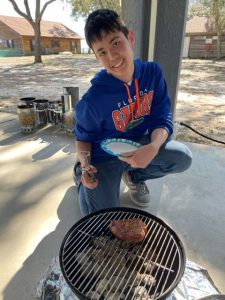
Youth learning to grill during 4-H tailgate program
Many of us will be celebrating with picnics, cookouts, and family get-togethers. One of my colleagues in Clay County, Samantha Murray, did a great article about preventing food poisoning while celebrating. Our youth have also been attending grilling summer camp programs and learning many of these tips plus lots more. The youth have learned about how to use a grill safely, how to prepare food safely and prevent cross-contamination or food-borne illness, and the nutritional benefits of animal protein in diets. Our district will have its annual competition to advance to the state-level competition on July 30 at the Washington County Extension Office, in Chipley, Florida.
I just wanted to take a moment to recap the tips Samantha gave to keep all of us safe and healthy while celebrating.
- Keep raw meats in a separate cooler than ready-to-eat items or beverages.
- Foods with mayonnaise are less acidic creating a better environment for bacterial growth
- Chicken and ground beef needs to be cooked to 165°F
- Wash hands if soap and water are not available use hand sanitizer to reduce the risk of contaminating food.
- Use different tongs or spatulas for cooked and uncooked meat or wash them after being in contact with raw meat.
- It is recommended to refrigerate leftovers within two hours unless it’s really hot, then the window shrinks to about an hour.
Other items you may want to think about.
- Keep beverages in a separate cooler from other foods, people will be going in and out of beverage coolers much more keeping the temperature higher and allowing bacterial growth.
- Cook cuts of pork, beef, or shrimp to 145°F
- Don’t sit charcoal grills on plastic tables and make sure the area is free from debris that can catch fire, including limbs or tents overhead.
- Clean up after yourself leaving only footprints in the area you were in!
- Enjoy time with friends and family safely!
For more information about educational programs, check out our webpage or contact your local UF IFAS Extension Office.
by Claire Davis | Mar 25, 2022
Being in the great outdoors is a great way to spend your time with family! What are some ideas for activities you can do outdoors with your friends and family? Some of the best outdoor activities could include going for a hike, swimming, hunting, kayaking, or even building a campfire. With the weather still cool and a little dry here in Northwest Florida, sitting around a campfire sounds like the right kind of fun! However, it is extremely important to be sure that your campfire does not put anyone at risk of wildfires or burns.
Check out some of the fire safety tips below!

- Use a designated fire pit, if available. If this is not an option, clear a space on the ground, removing any grass or needles that could potentially catch fire.
- Build your fire downwind and away from tents, houses, or anything that is flammable. What does flammable mean? Anything that can easily set fire is flammable. The USDA suggests a minimum of at least 3 feet away from anything that can catch fire.
- Have water or something to douse the fire nearby. In the event of fire escaping its designated area, you will need to be able to put it out swiftly to prevent a wildfire. Consider a water hose that is hooked up to a water source or a fire extinguisher. Also, before leaving your fire site, make sure the fire is extinguished!
- You know the drill! Stop, Drop, and Roll! Make sure that everyone present knows how to put out a clothing fire with these three simple steps.
- Never leave children unattended around a fire. As the adult, it is your responsibility to make sure that everyone is safe! Also, store matches, lighters, and lighter fluids out of children’s sight and reach.
- Think about what you are wearing. Do not wear open toed shoes, as a spark could come off a flame and burn your toe. Instead, wear closed toed shoes while around the fire. Do not wear loose fitting clothing. If you lean over a fire with a baggy t-shirt on, chances are your shirt could catch on fire. Wearing snug-fitting clothing is an easy way to prevent this from happening.
Another “hot” topic is grilling! As we all know, fire and charcoals are extremely hot. Make safe cooking a priority, especially when it comes to outdoor grilling. With summer coming, grilling will become a more popular activity!
A great way for you youth to learn about safe grilling practices is for them to attend a 4-H Tailgate Grilling Camp! This summer,

Youth learning to grill pork safely!
Calhoun and Liberty County 4-H Agents, Claire Reach and Marie Arick will be teaming up to offer this program to area youth. Youth will not only learn about the importance of fire safety, but also how to mix rubs or marinades for their meats, and how to grill different animal proteins!
If this is something you think your child or a youth you know might be interested in, stay tuned for upcoming date announcements for summer camps. If you have questions, comments, or concerns, please give us a call at the UF/IFAS Extension Calhoun County Office: (850)-674-8323.
An Equal Opportunity Institution.
Sources:
https://www.firesafekid.org/family-fire-safety/outdoor-fire-safety/
https://www.usfa.fema.gov/downloads/fief/outdoor_fire_safety.pdf
by Heather Kent | Aug 30, 2021
 Permission to use the 4-H name and emblem is granted through our club chartering process. Club charters are granted on an annual basis. 4-H agents meet with club volunteers at the beginning of each 4-H year to make sure clubs meet this criterion, then the information is updated in our online enrollment system. This blog post covers each criterion and includes links to helpful resources for members, parents, and volunteers.
Permission to use the 4-H name and emblem is granted through our club chartering process. Club charters are granted on an annual basis. 4-H agents meet with club volunteers at the beginning of each 4-H year to make sure clubs meet this criterion, then the information is updated in our online enrollment system. This blog post covers each criterion and includes links to helpful resources for members, parents, and volunteers.
- First, clubs need at least two appointed volunteers who have completed the application, screening, and orientation process. If you are not sure of your volunteer status, ask your local UF/IFAS Extension agent. Our volunteers must be re-screened every five years or in the event they have had a 90 day (or more) lapse in service.
- Second, clubs need to have at least five members from two different families enrolled in the 4-H program. If you need to recruit some new members, word of mouth is a great strategy, but your local 4-H agent would be happy to help. You can also check out a previous blog post about club marketing tips: Facebook Tips for 4-H Clubs, Instagram Tips for 4-H Clubs, Club Marketing Basics
- Third, clubs must have a non-discriminatory name. You don’t want anything in the club name giving the impression that the club is not open to a certain group- such as only males or only females, or only members of a certain religion. It is also important that “4-H” is in the name of the club. For example, instead of the “Clover Bakers,” “Clover Bakers 4-H Club,” or “4-H Clover Bakers” is more appropriate. This fact sheet can help guide clubs when selecting a name.
- Fourth and finally…clubs need to have an established meeting date, time, and location with a minimum of six meetings. In 4-H, we commonly refer to this as the club program. We have several tools to help members and volunteers plan the club year. For younger youth, the Clover Planning worksheet is a great tool. For other youth, the club planning guide is a great resource. You can also download this fillable PDF from Idaho 4-H to plan and share your club program.
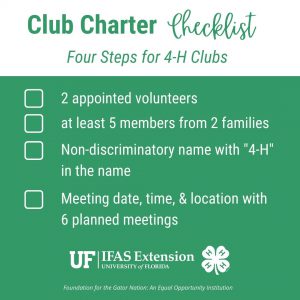 When it comes to club chartering, just remember 4 for 4: there are FOUR criteria to charter 4-H clubs. The process is fairly straightforward, but if you need assistance with any of the steps, check out the links in this blog, or reach out to your local UF/IFAS Extension Office– we want your club to be successful and are happy to help!
When it comes to club chartering, just remember 4 for 4: there are FOUR criteria to charter 4-H clubs. The process is fairly straightforward, but if you need assistance with any of the steps, check out the links in this blog, or reach out to your local UF/IFAS Extension Office– we want your club to be successful and are happy to help!

 peer teaching. Have teens assigned to new members that join in order to teach them the 4-H pledge, motto, club expectations, member names, etc. This creates a greater sense of belonging and fosters a supportive environment within the club for new members to engage more quickly and successfully.
peer teaching. Have teens assigned to new members that join in order to teach them the 4-H pledge, motto, club expectations, member names, etc. This creates a greater sense of belonging and fosters a supportive environment within the club for new members to engage more quickly and successfully.










